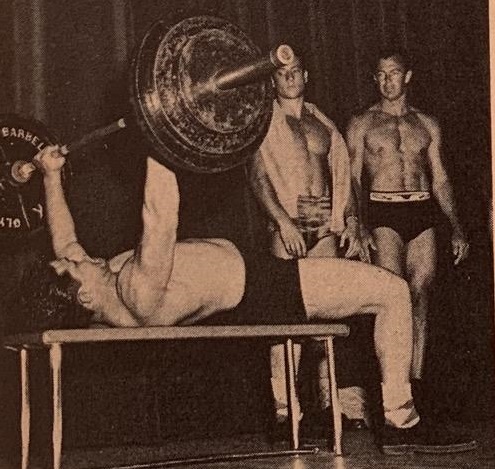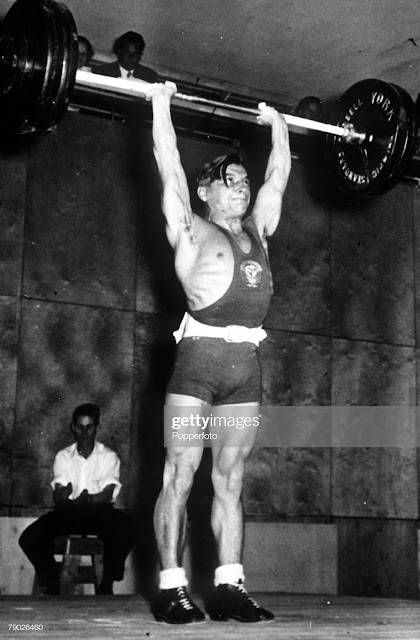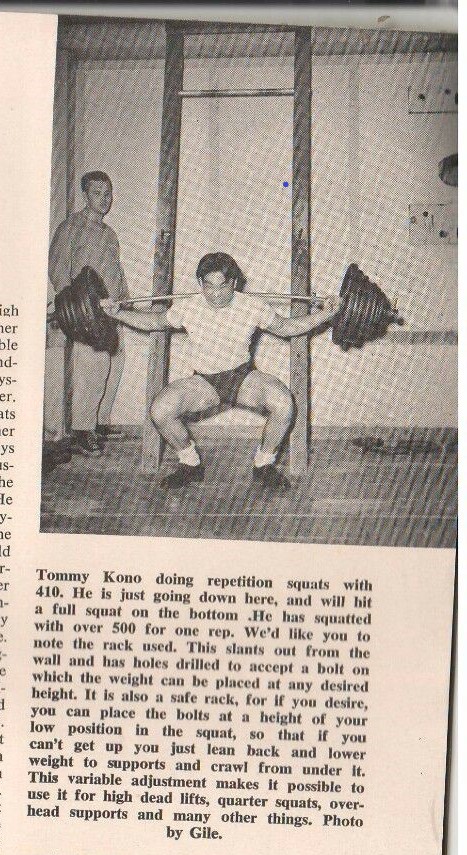Article Series Courtesy of Liam Tweed
The Press - Part Two
In the last article we dealt with the initial and slightly advanced stages of performance on the Press. First of all here we will deal with assistance exercises to complete the schedule we commenced last month.
Before doing so I must pay tribute to W.A. Pullum who first devised these assistance exercises, who first used these in conjunction with my own training, and has given permission for me to use them here in detail.
First, some very basic performance checks on the Press, by W.A. Pullum, here:
Figure 1: How NOT to hold the bar at the chest for the Press. Bar should be directly over the wrists, NOT at the ends of fingers.
Figure 2: How NOT to try to get past the sticking point. Forward inclination of the head and depression of the chin only tends to increase the difficulty.
Figure 3: How NOT to finish a Press -- or any overhead lift, for that matter. Forcing the bar too far back has inclined the trunk forward correspondingly -- not only a weak position, but a dangerous one.
Figure 2: How NOT to try to get past the sticking point. Forward inclination of the head and depression of the chin only tends to increase the difficulty.
Figure 3: How NOT to finish a Press -- or any overhead lift, for that matter. Forcing the bar too far back has inclined the trunk forward correspondingly -- not only a weak position, but a dangerous one.
"The First Assistance Exercises" - an article by Halliday on Pullum and the use of assistance movements, here:
Back to the original article . . .
THE SEATED PRESS does not at first glance appear to be much different from the normal Press. Instead of standing, you press whilst seated on a chair.
BUT! There is a BIG difference. To do the movement correctly it is not enough just to sit. I have seen people performing this movement whilst seated on the edge of the chair. This is absolutely no good at all.
You must sit well back, putting yourself IN AN ALMOST SEATED MILITARY POSITION, then you will see where the good effect result.
In this position no assistance can be obtained from the legs, and it is almost impossible to deviate from the correct position.
THE ONLY WAY YOU CAN PRESS THE WEIGHT IS TO PRESS IT!
This is what we want. This is the way to build power - having to use power!
In attempting this exercise I advise first of all that you commence with about 50 lbs. below your maximum Press. Find a weight you can do 6 sets of 3 reps with, and keep these sets constant, using small discs (1/2 or 1 lb.) periodically for progression.
The next, THE HALF PRESS, is an excellent exercise for promoting power at a most important time, i.e., the point at which the weight usually sticks. First you snatch the weight to arms' length using a press grip. Then lower the weight slowly to approximately just over eye level and press back to arms' length without backbend.
Again do 6 sets of 3 reps, and use the small discs to progress. You will find that 60 lbs. below your limit will probably suffice but as everyone's potentialities very you must experiment to find your best poundage to do the requisite reps with.
The third and last movement is with DUMBBELLS. It is simply the ordinary two handed press with dumbbells with a slight variation. Instead of holding the weights normally at the shoulders you bring the hands round to the front, so that your fingers are actually on the pectorals. From here you execute a normal press.
Again, you must find your own poundage but it is essential to do the correct reps, which on this movement will be 4 sets of 8 reps.
The advanced lifter is a different proposition altogether.
When he reaches a certain peak it becomes hard work to increase his performance by even a minimum amount. By this stage his style has become set, he has attempted many varied and bizarre schedules in endeavors to improve, and he sometimes feels he has exhausted his potential.
It is probable that at this stage his only hope of improvement lies in development of additional power! He must become stronger. It is most important that he does not succumb to the "5 lb. complex." By this I mean he must not limit himself to looking to small increases. He must not, because he has reached a certain standard, become resigned to hovering around certain poundages. He must be even more ambitious than he was previously. Even if his ideals are actually fantastic, he will reach greater heights if he honestly endeavors to reach these ideals, than if he limits himself mentally by having reserved estimates of his capabilities.
The assistance exercises again can prove of immense value.
Not only as sources of improved power, but as a means of providing a change in training. Many a time I have gone on to these movements solely, doing no Olympics whatsoever, for weeks at a time. When I have returned to Olympic training I have not only been the stronger for practicing such movements, but have felt the benefits of the change and have had additional jest and enthusiasm.
The experienced lifter has one big advantage. The most retarding thing against progress is boredom. The way to promote boredom is an excess of repetition work. The really trained man does not need a lot of repetition work. His primary reps should be only in the nature of warming up movements. All his energy should be conserved for what he wants to do most -- elevate BIG poundages.
Not maximum poundages, bear in mind, but as near so as possible.
You must lift heavy weights to be able to lift heavier weights. I have been making this plea for years. Some of my associates have decried my ideas on this subject, yet having seen the world's best lifters train I know this is their principle. You never see them do many reps. They attain maximum training poundages as soon as possible in their workout, merely ensuring their muscles are warmed up for the task. Years ago I realized this and based my own training on what I had observed.
In an article John Davis said his best pressing schedule was 10 sets of 2 reps with what weights he could handle.
I saw Kono do 2 reps on the Clean with a poundage only 6 lbs. below the world's record -- in training!
I saw Davis do innumerable single snatches with a top training poundage, and Pete George did a similar total to the one he won his class-weight with -- also in training.
Do not forget I am not talking to the experience men, that is why I am giving experience men as examples. They themselves will be the first to decry that they are supermen. They may have natural abilities but more importantly they are men who have trained on the appropriate methods.
During your preliminary training by all means do not neglect your repetition work. But in the advanced stages you must concentrate on heavy poundages.
Heavy lifting is HARD WORK . . . YOU CANNOT SUCCEED WITHOUT IT.
I conclude by giving you two Press schedules for the advanced man. Simple schedules, yet their purpose is clear. They are based on a maximum Press of 200 lbs.
Schedule One:
Warm up.
4 reps with 140
4 x 160
2 x 175
8 sets of 2 with 190.
Schedule Two:
Warm up.
4 x 150
3 x 165
2 x 180
10 singles with maximum poundage possible.
Twice weekly, combined with assistance work, also twice weekly, and work out to maximum once each two weeks.

























